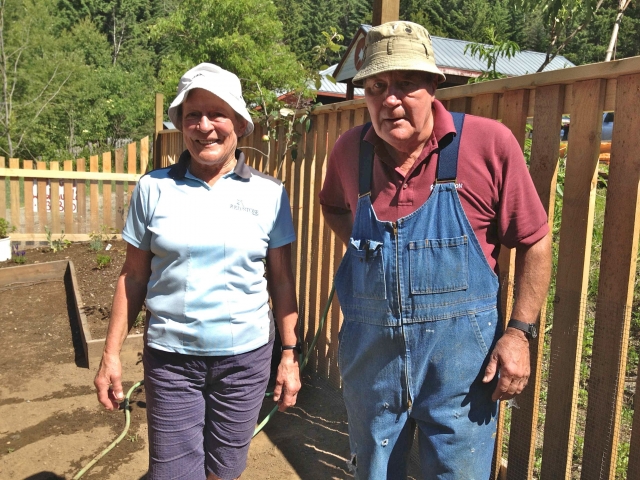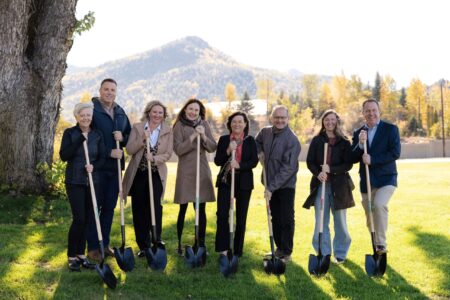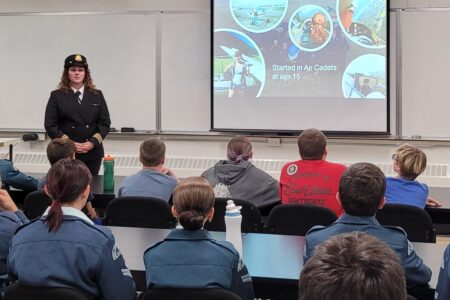Heritage Garden gets growing at the Le Roi Mine
The stars have finally aligned for the new Heritage Garden built last fall and this spring, and planted at the end of our cool, wet June, at the site of the Le Roi Mine above the Rossland Museum.
Last week we caught up with Libby and Iain Martin for a tour of their hard work and that of other volunteers, in particular Andy Cant and Angela Price.
“It’s not huge,” Libby said modestly about the garden’s eight large raised beds with walkways and space for future brick and stone patios. “We just hope to make it a pleasant place to sit and enjoy,” she said.
The idea of a garden for picnickers and tourists to enjoy beside the many outdoor attractions at the Le Roi Mine site was suggested two years ago during the Museum Select Committee process that aimed to chart a course for the museum given the temporary—now permanent—closure of the mine tour itself.
“Joyce [Austin, manager of the museum,] wanted to do an indoor display on farms and gardens and we thought, why not do an outside and an inside? That’s how the idea was born,” Libby said.
The indoor display was also completed recently with half on the history of gardens and the other half on Rossland’s farms. The display includes old tools, an ice cream maker, a butter churn, lots of photos, and an especially interesting and informative map that labels all the farms, hobby farms, and dairies that have existed in Rossland. The youngest member of the display is a description of the new Community Garden north of RSS.
Eighteen months ago the museum submitted a proposal for the Heritage Garden, and last May funding was approved by the Columbia Kootenay Cultural Alliance—a branch of the Columbia Basin Trust. Work couldn’t start, however, until the fall when the city donated a machine and operator to prepare the ground.
“This spring we really got cracking,” Libby said. Andy Cant and Iain knocked together the raised beds, sank fence posts, and built the fence, gate, and trellis in a blitz of some 30 hours of labour each. They sourced the wood from Bruce Robinson, The Kootenay Sawyer, who runs local timber through his portable mill just a few hundred metres west of the museum.
Top soil is normally an expensive input for a new garden, but as Harry LeFevre Square was prepared for its makeover as part of the Columbia-Washington project, the soil was sent over to the Heritage Garden to enjoy a new life out there, amended with sheep manure and peat moss.
“The city’s been very generous,” Libby said, “and we’ve had very generous donations, including a lot of plants, and help from volunteers of course.” Between generosity and unexpected savings, Libby said, “We haven’t had to spend nearly as much money as we thought.”
The money left in the grant can now be put towards some finishing touches, such as a brick patio with a bench that will incorporate two old coal scuttles, a stone-paved area for a bird bath, and an arbor built from two mining ladders—relics from a stope—and some heritage corrugated iron roofing all of which will be grown over with Clematis. An old rusty plough will have pride of place too, helping to round out the heritage theme.
Libby also hopes people might donate benches and tables to place near the garden to help make the site even more welcoming for picnickers.
The garden beds themselves were planted over the last two weeks by Angela Price and Libby. They chose a mixture of ornamental and edible plants, but the tender greens were soon met by an onslaught of Columbia ground squirrels. Even as we toured the area, Libby tended to ravaged plants while Iain worked hard at additions to the fence to keep the critters out.
“We knew it would be a bit of a problem,” Libby said, “We’ve got a huge Columbia ground squirrel population at the museum.”
“They’re not touching the zucchini or squash,” she said hopefully, “but they like delphiniums.” Potatoes, peas, rhubarb, and other edibles are mixed in with a wide variety of herbs and flowers as Libby and Angela experiment with what will work in ground squirrel country.
“We learned down there [closer to the museum itself] that they don’t eat geraniums and they don’t eat alyssums. That’s why it’s all geraniums and alyssums over there!
The heritage garden, she hopes, will have greater diversity. “We’re learning what we can plant,” she said, still developing her gardening skills despite having worked her green thumb since she was a child. “What else can you do? I’ve dealt with pocket gophers at home. I’ve watched them pull a petunia down into their burrow, down it goes. But these things…?”
When the plants are firmly rooted and the ground squirrels securely excluded, she hopes all the volunteer effort and generous donations will pay back. She hopes it will help convince people to come to the Le Roi Mine for picnics and family day trips, giving a splash of natural colour to complement the many fascinating, historic, and educational objects that already fill the area.
To donate time, money, or material to the museum or the Heritage Garden project, contact the Rossland Historical Museum at (888) 448-7444 or email rosslandmuseum@netidea.com. The museum is open every day from 9 a.m. to 5 p.m. Visit the museum online at www.rosslandmuseum.ca.























